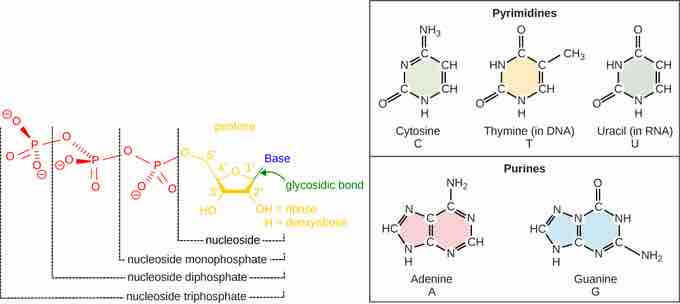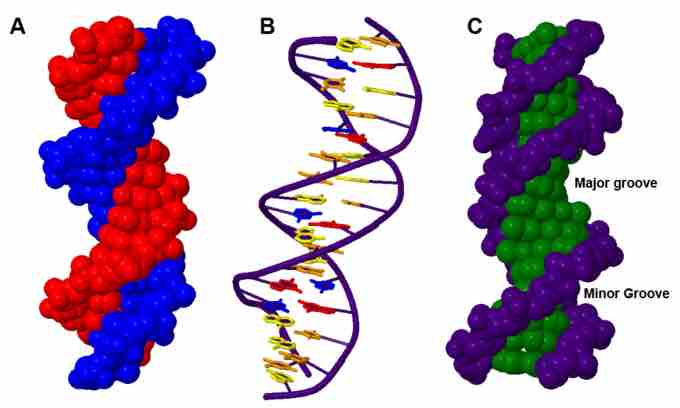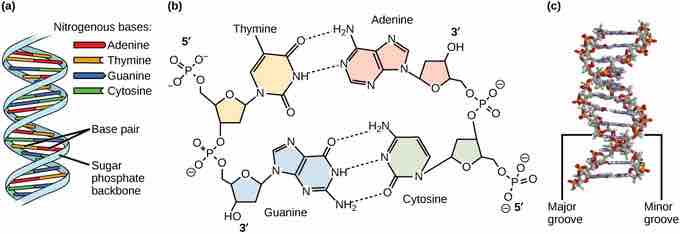The monomeric building blocks of DNA are deoxyribomononucleotides (usually referred to as just nucleotides), and DNA is formed from linear chains, or polymers, of these nucleotides. The components of the nucleotide used in DNA synthesis are a nitrogenous base, a deoxyribose, and a phosphate group . The nucleotide is named depending on which nitrogenous base is present. The nitrogenous base can be a purine such as adenine (A) and guanine (G), characterized by double-ring structures, or a pyrimidine such as cytosine (C) and thymine (T), characterized by single-ring structures. In polynucleotides (the linear polymers of nucleotides) the nucleotides are connected to each other by covalent bonds known as phosphodiester bonds or phosphodiester linkages.

Nucleotide Structure
Each nucleotide is made up of a sugar, a phosphate group, and a nitrogenous base. The sugar is deoxyribose in DNA and ribose in RNA. In their mononucleotide form, nucleotides can have one, two , or three phosphates attached to them. When linked together in polynucleotide chains, the nucleotides always have just one phosphate. A molecule with just a nitrogenous base and a sugar is known as a nucleoside. Once at least one phosphate is covalently attached, it is known as a nucleotide.
James Watson and Francis Crick, with some help from Rosalind Franklin and Maurice Wilkins, are credited with figuring out the structure of DNA. Watson and Crick proposed that DNA is made up of two polynucleotide strands that are twisted around each other to form a right-handed helix.
The two polynucleotide strands are anti-parallel in nature. That is, they run in opposite directions.
The sugars and phosphates of the nucleotides form the backbone of the structure, whereas the pairs of nitrogenous bases are pointed towards the interior of the molecule.
The twisting of the two strands around each other results in the formation of uniformly-spaced major and minor grooves bordered by the sugar-phosphate backbones of the two strands.

Three representations of DNA's double helical structure.
A is a spacefill model of DNA, where every atom is represented as a sphere. The two anti-parallel polynucleotide strands are colored differently to illustrate how they coil around each other. B is a cartoon model of DNA, where the sugar-phosphate backbones are represented as violet strands and the nitrogenous bases are represented as color-coded rings. C is another spacefill model, with the sugar-phosphate atoms colored violet and all nitrogenous base atoms colored green. The major and minor grooves, which wrap around the entire molecule, are apparent as the spaces between the sugar-phosphate backbones.
The diameter of the DNA double helix is 2 nm and is uniform throughout. Only the pairing between a purine and pyrimidine can explain the uniform diameter. That is to say, at each point along the DNA molecule, the two sugar phosphate backbones are always separated by three rings, two from a purine and one from a pyrimidine.
The two strands are held together by base pairing between nitrogenous bases of one strand and nitrogenous bases from the other strand. Base pairing takes place between a purine and pyrimidine stabilized by hydrogen bonds: A pairs with T via two hydrogen bonds and G pairs with C via three hydrogen bonds.
The interior basepairs rotate with respect to one another, but are also stacked on top of each other when the molecule is viewed looking up or down its long axis.
Each base pair is separated from the previous base pair by a height of 0.34 nm and each 360o turn of the helix travels 3.4 nm along the long axis of the molecule. Therefore, ten base pairs are present per turn of the helix.

DNA Structure
DNA has (a) a double helix structure and (b) phosphodiester bonds. The (c) major and minor grooves are binding sites for DNA binding proteins during processes such as transcription (the copying of RNA from DNA) and replication.
DNA sequencing is the process of determining the precise order of nucleotides within a DNA molecule. Rapid DNA sequencing methods has greatly accelerated biological and medical research and discovery. Knowledge of DNA sequences has become indispensable for basic biological research, and in numerous applied fields such as diagnostics, biotechnology, forensic biology, and biological systematics. The rapid speed of sequencing attained with modern technology has been instrumental in obtaining complete DNA sequences, or genomes, of numerous types and species of life, including the human genome and those of other animal, plant, and microbial species.